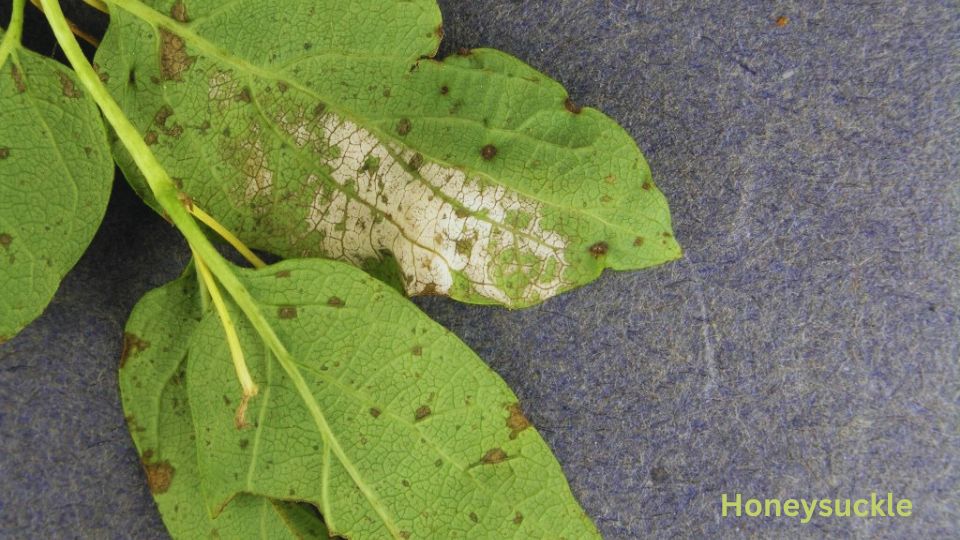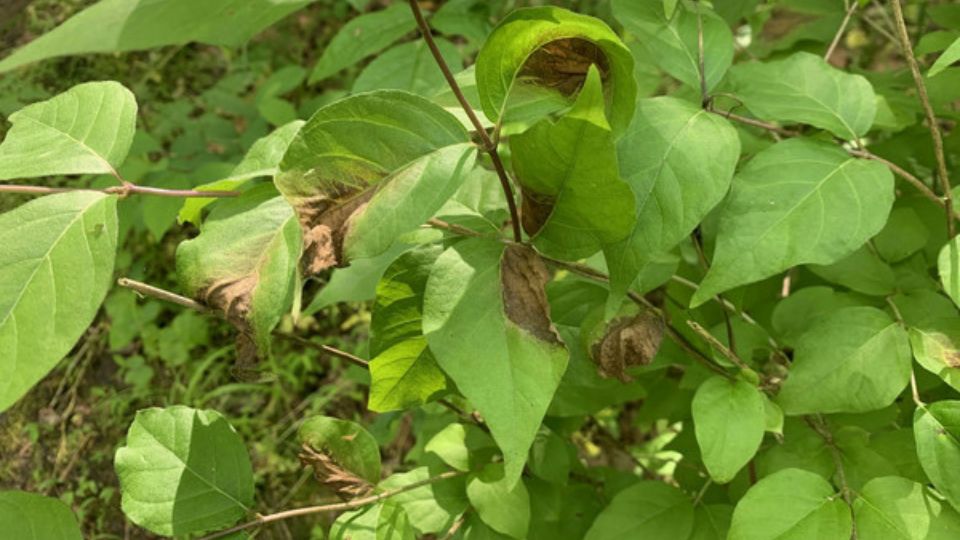
When your honeysuckle leaves turning yellow, people start asking, ‘Is It Normal to Have Yellow Honeysuckle Leaves?’ Well, yellow honeysuckle leaves can be normal during seasonal changes, especially in autumn.
However, persistent yellowing may indicate issues like overwatering, nutrient deficiencies, pest infestations, or disease. So, keep calm and read the rest of the parts with utmost care.
Reasons Why Honeysuckle Leaves Turning Yellow
Honeysuckle leaves may turn yellow due to various reasons, and it’s essential to identify the cause to provide appropriate care. Some common factors leading to yellowing leaves include:
- Seasonal Changes: It’s normal for some honeysuckle leaves turn yellow and drop during seasonal transitions, particularly in autumn. This is a natural response to changing light and temperature conditions, and it doesn’t necessarily indicate a problem.
- Overwatering or Underwatering: Incorrect watering practices can lead to stress in the honeysuckle plant. Overwatering can cause root suffocation and root rot, which impairs the plant’s ability to take up nutrients, leading to yellowing leaves. On the other hand, underwatering can result in drought stress and leaf wilting.
- Nutrient Deficiency: Honeysuckle plant requires essential nutrients like nitrogen, iron, magnesium, and others to thrive. A lack of these nutrients in the soil can lead to nutrient deficiencies, manifesting as yellowing leaves. For example, nitrogen deficiency causes the yellowing of older leaves first.
- Pest Infestations: Insect pests, like aphids, spider mites, or whiteflies, can infest honeysuckle plants and feed on their sap. As they consume plant fluids, they can cause significant damage and weaken the plant, leading to yellowing, wilting, and even curling of leaves.
- Environmental Stress: Honeysuckle plants may face stress due to extreme weather conditions. Exposure to high temperatures, excessive sunlight, or strong winds can cause dehydration and lead to yellowing and browning of leaves.
- Root Issues: The health of a plant is highly dependent on its root system. Physical damage to the roots or compacted soil can restrict water and nutrient uptake, resulting in yellowing leaves as the plant struggles to maintain its metabolic functions.
Problems & Solutions at A Glance: Honeysuckle Leaves Turning Yellow
Here is a problem and solution table on honeysuckle leaves turning yellow:
| Problem | Possible Solutions |
| Seasonal changes | Normal, no action is needed |
| Overwatering or underwatering | Adjust watering frequency and drainage |
| Nutrient deficiency | Apply balanced fertilizer for honeysuckle |
| Pest infestations | Use insecticides or natural remedies |
| Fungal (e.g., blight) | Apply fungicides, prune affected parts |
| Environmental stress | Provide shade, wind protection, or mulch |
| Root issues | Improve soil aeration and avoid root damage |

Solutions Explained: Honeysuckle Leaves Turning Yellow and Falling Off
If the problem persists or worsens despite your efforts, consider seeking advice from a local gardening expert or horticulturist for further diagnosis and personalized recommendations. Also go through the following points;
Seasonal Changes
Yellowing and falling leaves during seasonal transitions, like autumn, are a normal part of the plant’s life cycle. As the days shorten and temperatures drop, the plant redirects nutrients from older leaves to new growth, causing the older leaves to turn yellow and eventually drop off. No specific action is needed for this natural process.
According to Kentucky Native Plant Society :
In the fall, Amur honeysuckle typically senesces (leaves turn yellow and drop) in late October to mid-November, and sometimes not until early December. Native trees and shrubs typically break bud late March to mid-April and do not fully expand until early May.
Overwatering or Underwatering
Both overwatering and underwatering can stress the winter honeysuckle plant and lead to yellowing leaves that eventually fall off. To address this, it’s important to strike a balance in watering.
Check the soil moisture regularly, and only water when the top inch of soil is dry for potted plants or when the top 2-3 inches are dry for plants in the ground. Ensure proper drainage to prevent waterlogged roots.
Nutrient Deficiency
Yellowing leaves can result from a lack of essential nutrients. Applying a balanced honeysuckle fertilizer that includes nitrogen, phosphorus, and potassium, as well as micronutrients like iron and magnesium, can help address deficiencies.
Follow the recommended dosage and frequency for the specific fertilizer for honeysuckle and the age of the plant.
Pest Infestations
Insect pests can cause stress to the honeysuckle plant, leading to yellowing and dropping of leaves. Identify the specific honeysuckle pests affecting the plant and use appropriate insecticides or natural remedies to control their population.
Regularly inspect the plant and neighboring vegetation for signs of infestation.
Fungal (e.g., blight)
Fungal infections can cause yellow spots and patches on honeysuckle leaves, leading to leaf drop. To combat fungal diseases like honeysuckle leaf blight, prune away affected parts and dispose of them properly.
Apply fungicides labeled for honeysuckle leaf blight treatment, following the instructions on the product. Improve air circulation around the plant to reduce humidity and discourage fungal growth.
Environmental Stress
Extreme environmental conditions like high temperatures, excessive sunlight, or strong winds can stress the honeysuckle plant, leading to honeysuckle leaves turning yellow and falling leaves.
Provide shade to the plant during the hottest part of the day, especially in hot climates. Consider using windbreaks or relocating the plant to a more sheltered area.
Root Issues
The health of the plant is closely tied to the condition of its roots. Avoid damaging the roots during planting or maintenance activities. Improve soil aeration by incorporating organic matter, like compost, into the soil. Mulching around the base of the plant can also help retain moisture and regulate soil temperature.
By addressing these potential causes and implementing appropriate solutions, you can help your honeysuckle plant recover and maintain healthy, green foliage throughout its growing season.
Last time I Covered, Best Physan 20 Alternatives. You can check this content too in your spare time.
How to Treat Honeysuckle Leaf Blight
Treating honeysuckle leaf blight involves a combination of cultural practices and fungicidal treatments. Here’s a step-by-step guide on how to manage and treat honeysuckle leaf blight:
Step 1: Prune Affected Parts
Start by removing and disposing of any visibly infected leaves, stems, or branches. Make clean cuts to avoid further spreading the disease.
Step 2: Sanitation
Keep the area around the honeysuckle plant clean. Rake up and remove fallen leaves to prevent the overwintering of fungal spores.
Step 3: Fungicide Application
Apply a fungicide specifically labeled for honeysuckle leaf blight. Common fungicides used for this purpose contain active ingredients like chlorothalonil or mancozeb. Follow the manufacturer’s instructions regarding the dosage and application
Step 4: Timing of Fungicide Application
For effective control, begin fungicide treatment at the first signs of leaf blight and continue at regular intervals as recommended on the fungicide label.
Step 5: Avoid Overhead Watering
Water at the base of the plant to avoid splashing water on the leaves, as this can spread the fungal spores.
Step 6: Improve Air Circulation
Trim nearby vegetation or branches that may be obstructing air circulation around the honeysuckle plant. Proper airflow helps reduce humidity, making the environment less favorable for fungal growth.
Step 7: Mulching
Apply a layer of organic mulch around the base of the plant. Mulch helps retain soil moisture and regulates temperature, creating a less favorable environment for the fungus.
Step 8: Avoiding Excessive Fertilization
High-nitrogen fertilizers can promote succulent growth, which may be more susceptible to fungal honeysuckle vine-diseases’. Use a balanced honeysuckle fertilizer to avoid excessive vegetative growth.
Step 9: Quarantine
If you have multiple honeysuckle plants, isolate any infected plant from healthy ones to prevent the spread of the disease.
Step 10: Monitor and Continue Treatment
Regularly inspect the plant for any signs of new infections or disease recurrence. Continue with the fungicide treatment and cultural practices as needed.
Remember, prevention is essential in managing honeysuckle leaf blight. Providing good cultural care, ensuring proper pruning and sanitation practices, and promptly treating the early signs of the disease can significantly reduce its impact on your honeysuckle plants.
If the issue persists or becomes severe, seeking advice from a local gardening expert or horticulturist can be helpful in implementing an effective treatment plan.

When to Call a Gardening Expert for Yellow Honeysuckle Leaves?
If your honeysuckle leaves keep turning yellow despite your care, it might be time to consult a gardening expert. Signs like black spots, repeated cases of honeysuckle leaf blight, or severe leaf drop can point to deeper issues such as fungal infections or root problems.
Persistent yellowing even after adjusting watering, feeding, and sunlight may also signal a soil imbalance or hidden pest infestation. A local horticulturist can test your soil, inspect the roots, and recommend tailored treatments. Getting expert advice early can save the plant and prevent the issue from spreading to nearby greenery.
FAQs
How do I know if my honeysuckle plant is overwatered or underwatered?
Overwatered honeysuckle may show signs of wilting despite being well-watered, and the soil may be consistently wet. Underwatered plants may have drooping leaves, and the soil will be dry to the touch. Adjust watering based on the soil moisture and the plant’s specific needs.
Are yellowing honeysuckle leaves always a sign of a problem?
Not necessarily. Some yellowing may be normal during seasonal changes or due to natural leaf aging. However, persistent and widespread yellowing can indicate underlying issues like pests, diseases, or environmental stress, which may require attention and action.
Can I use homemade remedies to treat honeysuckle leaves yellow?
Yes, there are some homemade remedies that may help with certain issues. For example, neem oil can be effective against some pests, and a mixture of water and baking soda can act as a fungicidal spray. However, their effectiveness can vary, and it’s best to use commercial products for more severe problems.
borshon96
Recommended

9 Effective Tips for Balcony Gardens for Beginners

Best Homemade Fertilizer: Banana Peel for Plants


Philodendron Neon Heartleaf: Your Most Obedient Houseplant



